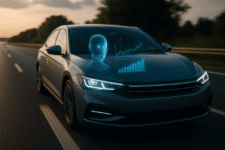
The automotive industry is undergoing one of the most profound transformations in its history. Once defined by mechanical engineering and horsepower, today’s vehicles are increasingly shaped by code. We’re entering the era of software-defined vehicles (SDVs) where the intelligence of the car comes less from the engine block, but from lines of software. A recent study by Research and Markets projects that the global SDV market will grow from $213.5 billion in 2024 to over $1.2 trillion by 2030. That scale of growth is no surprise to those working at the intersection of software, mapping and AI. It’s a reflection of how rapidly the role of AI is expanding across every aspect of mobility.
AI will increasingly become the digital engine behind some of the most valuable vehicle functions: digital cockpits with natural language prompting, real-time navigation and dynamic routing, predictive maintenance, advanced driver-assistance systems (ADAS) and higher levels of automated driving. AI is helping to redefine and customize the driver experience. According to a recent IBM study, 74% of automotive executives believe that by 2035 vehicles will be both software-defined and AI-powered. And by then, 80% of new cars are expected to feature electric powertrains, providing an even more natural foundation for integrating vehicle systems, mapping, software and AI capabilities.
AI-Powered Mapping: The Digital Compass of SDVs
A particularly compelling example of AI’s role is in the evolution of digital mapmaking. A traditional static map is giving way to a “live” map: dynamic, constantly streamed representations of the road environment used to power an array of vehicle systems. A map is essential for safe and efficient driving in an increasingly electric, connected and automated vehicle.
A live map provides much more than simple navigation, enabling the vehicle to interpret its surroundings and make informed driving decisions in real-time. AI’s ability to detect patterns, recognize environmental changes, and update map data dynamically makes it possible for the driver (and vehicle systems) to avoid construction zones, reroute around traffic accidents and become aware of changes in road signage or speed limits.
We are already seeing live map capabilities that continuously integrate data from vehicle sensors, satellite imagery and crowdsourced input, among other sources, to reflect changing road conditions. The ability to unify multiple sources of data, automated and powered by AI and machine learning, unlocks the true potential of a live map.
The Personalized Vehicle: Intelligent, More Intuitive In-Car Experiences
The driver experience is also becoming more personalized, more intuitive and more AI-driven. We’re seeing in-vehicle AI assistants that learn to respond to natural language and recognize patterns in driver behavior, enabling vehicles to adapt to individual preferences. AI assistants now offer natural language-prompted routing, EV charging recommendations, safety alerts based on driving conditions and dynamic itinerary suggestions that incorporate stops, preferences and real-time changes.
According to IBM’s study, 75% of executives believe software-defined experiences will be the core of an automotive brand’s value by 2035. This means a driver might receive a route suggestion not just based on the shortest travel time, but also factoring in dynamic elements like real-time weather, nearby EV charger availability and previous stops such as a favorite travel center or coffee shop. Over time, the vehicle becomes more of a travel companion that continues to learn and evolve with the driver.
AI as the Foundation for Assisted and Autonomous Functions
AI is also fundamental to the continued evolution of ADAS and autonomous driving functions. It will enable improved decision-making for vehicle safety and efficiency, from lane-keeping and adaptive cruise control to pedestrian detection and object recognition.
With SDVs advancing toward higher levels of autonomy, the combination of AI-powered mapping with on-board sensor inputs like LiDAR and cameras will be essential for accurate route planning, situational awareness and regulatory compliance.
Overcoming Roadblocks: Key Challenges in AI Integration
While the transformative value of AI in SDVs is vast, and enthusiasm for AI is high, several challenges must be addressed for widespread adoption:
- Data Integrity & Security: AI relies on large volumes of data, raising concerns about securing sensitive information while maintaining real-time accuracy. Automakers and software providers must ensure AI-driven location and vehicle data are protected from breaches and unauthorized access while complying with regulatory standards as vehicles become more connected.
- Interoperability & Standardization: While more companies develop AI-powered systems, it is essential to ensure that these technologies can work together across brands and suppliers to prevent fragmentation and improve cross-platform compatibility.
- Cloud & Edge Computing Infrastructure: Processing the massive amounts of real-time data generated by AI demands robust computing infrastructure. Continued advancements in cloud computing and edge processing will be critical to support AI applications in mapping, navigation, and vehicle automation.
The Future of an AI-Powered Map for SDVs
Looking to the future, a live map will become even more central to how vehicles operate, helping them interpret and respond to the world around them with increasing precision. The rise of digital twin technology, where AI creates real-time virtual replicas of vehicles, will also allow automakers to simulate, test and refine vehicle functions before they ever hit the road. Recent advances in AI-powered image recognition and cloud processing are enabling the automated extraction of real-world features from street-level imagery, helping automakers generate virtual environments that accelerate simulation, safety testing, and SDV development.
Beyond enhancing navigation and user experience, AI-driven analytics will increasingly be used to detect patterns in sensor and performance data, enabling earlier identification of maintenance needs. AI can trigger service alerts before traditional warning systems activate by recognizing subtle shifts in vehicle behavior, such as tire pressure changes or declining brake efficiency. These predictive insights will not only improve safety but also support more efficient, cost-effective vehicle and fleet management.
What’s clear is that this future will require strong partnerships between automakers, AI technology providers, cloud platforms and location data experts. No single organization can build it alone. But by working together, we can shape a safer, smarter and more connected automotive future.
As the industry continues its shift to software-defined architectures, the importance of real-time, AI-powered location intelligence will only grow.
The post Why AI-Powered Mapmaking is Essential to the New Era of Software-Defined Vehicles appeared first on Unite.AI.



